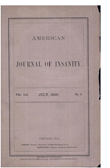Panic, agoraphobia, and vestibular dysfunction
Abstract
OBJECTIVE: Otoneurological abnormalities have been reported in panic disorder. The purpose of this investigation was to determine the prevalence of such findings in panic disorder with and without agoraphobia and to discern whether vestibular dysfunction was associated with specific symptoms. METHOD: Clinical audiological and vestibular tests were administered to 30 patients with uncomplicated panic disorder (without agoraphobia or with only mild agoraphobia), 29 patients with panic disorder with moderate to severe agoraphobia, 27 patients with anxiety but no history of panic attacks, 13 patients with depressive disorders but no history of anxiety or panic attacks, and 45 normal comparison subjects. Evaluators were blind to subjects' diagnostic group. Quantitative measures of subjects' discomfort with space and motion and of the frequency of certain symptoms between and during panic attacks were obtained. Anxiety state levels were measured during the vestibular tests. RESULTS: Vestibular abnormalities were common in all the groups but most prevalent in the patients with panic disorder with moderate to severe agoraphobia. Vestibular dysfunction was associated with space and motion discomfort and with frequency of vestibular symptoms between, but not during, panic attacks. There were no major differences between the two panic groups in anxiety levels during vestibular testing. There were no significant differences between groups on the audiological component of the test battery. Exploratory data analysis indicated that the constellation of vestibular tests most specific for agoraphobia was one indicating compensated peripheral vestibular dysfunction. CONCLUSIONS: Subclinical vestibular dysfunction, as identified by clinical tests, may contribute to the phenomenology of panic disorder, particularly to the development of agoraphobia in panic disorder patients.
Access content
To read the fulltext, please use one of the options below to sign in or purchase access.- Personal login
- Institutional Login
- Sign in via OpenAthens
- Register for access
-
Please login/register if you wish to pair your device and check access availability.
Not a subscriber?
PsychiatryOnline subscription options offer access to the DSM-5 library, books, journals, CME, and patient resources. This all-in-one virtual library provides psychiatrists and mental health professionals with key resources for diagnosis, treatment, research, and professional development.
Need more help? PsychiatryOnline Customer Service may be reached by emailing [email protected] or by calling 800-368-5777 (in the U.S.) or 703-907-7322 (outside the U.S.).



